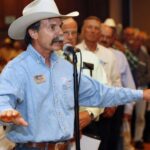Published: Tuesday, May 19, 2009
Peeved ranchers lambaste federal effort to ID herd animals
By Shannon Dininny
Associated Press
PASCO — Five years after the federal government started a program to trace livestock in the event of a disease outbreak, just 36 percent of ranchers are taking part.
U.S. Department of Agriculture officials found out why Monday, when 75 Western livestock producers gave them an earful during a meeting. The “listening session” was one of seven scheduled around the country in May and June to hear ranchers’ concerns, with the goal of increasing participation in the program.
Those concerns haven’t changed much in five years: The cost is too high for small farmers. The regulations amount to bureaucratic suffocation. The program neither prevents nor controls disease. And what’s in a farmer’s pasture is nobody’s business.
“This is the last of your freedom, boys. Freedom restricted is freedom lost,” said Bert Smith, a cattleman from Layton, Utah, who owns Ox Ranch in Ruby Valley, Nev.
The nationwide tracking system, started in 2004, is intended to pinpoint an animal’s location within 48 hours after a disease is discovered. Farmers were to have voluntarily registered their properties with their states by January 2008. Mandatory reporting of livestock movements was to begin one year later.
Just 36 percent (USDA’s numbers) of the nation’s estimated 1.4 million farm “premises,” which includes farms’ multiple locations, are registered.
As of March 31, the USDA has obligated $119.4 million toward the program, which it says will help ensure the safety of the food supply, particularly for export markets that may refuse to accept U.S. beef, pork or poultry during a disease outbreak.
During the recent swine flu epidemic, several countries banned U.S. pork products, even though there is no evidence the virus is spread by food.
The proposed system does nothing to prevent disease, and animal tracking would be better left for states to handle themselves, said Wade King, president of the Cattle Producers of Washington.
“USDA should be focused on preventing the disease instead of tracing it,” he said.
Carol Osterman of Akyla Farms in LaConner said her small farm of cattle, goats, pigs, llamas, poultry and horses would be forced to close if the suggested “regulatory burden” becomes a reality.
She recommended the program be eliminated, or at best, applied only to large, confined-animal feeding operations.
So far, the level of participation varies by livestock species, though no data was immediately available. USDA spokeswoman Joelle Schelhaus said the opportunity for improving participation in the cattle industry is highest due to its sheer size.
Separate surveillance programs for brucellosis and tuberculosis track fewer than 20 percent of cattle, while 90 percent of sheep are tracked under a similar surveillance program for scrapie.
Only two people spoke out strongly in favor of the program, one of them a representative for a company that supplies animal identification tags.





Hi! I like your article and I would like very much to read some more information on this issue. Will you post some more?
It’s a masterpiece. I have never thought people can have such ideas and thoughts. You are great.